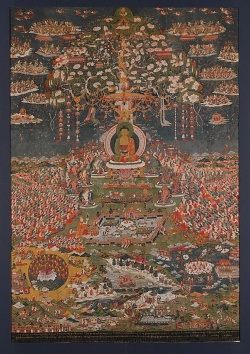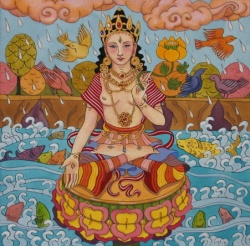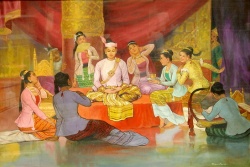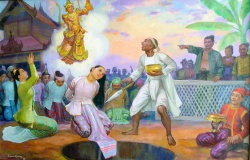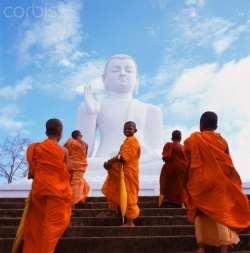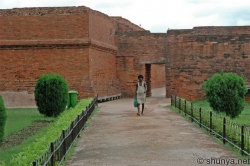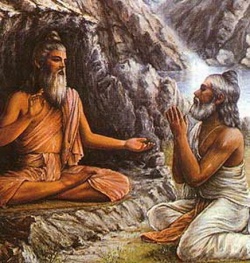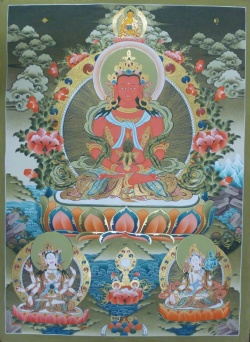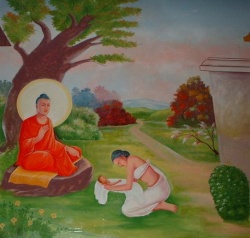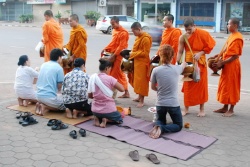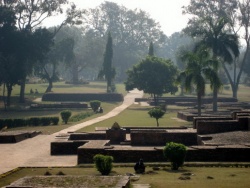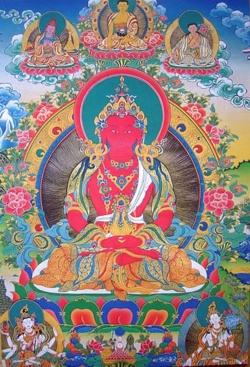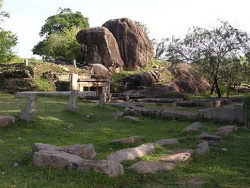Indian Buddhism
Buddhism is a world religion, which arose in and around ancient Kingdom of Magadha (now in Bihar, India), and is based on the teachings of Siddhārtha Gautama who was deemed a "Buddha" ("Awakened One"). Buddhism spread outside of Magadha starting in the Buddha's lifetime.
With the reign of the Buddhist Mauryan Emperor Ashoka, the Buddhist community split into two branches: the Mahāsāṃghika and the Sthaviravāda, each of which spread throughout India and split into numerous sub-sects. In modern times, two major branches of Buddhism exist: the Theravāda in Sri Lanka and Southeast Asia, and the Mahāyāna throughout the Himalayas and East Asia.
The practice of Buddhism as a distinct and organized religion declined from the land of its origin in around 13th century, but not without leaving a significant impact. Hindus continued to absorb Buddhist practices and teachings, such as Ahiṃsā and the renunciation of the material world. Buddhist practice is most common in Himalayan areas like Ladakh, Arunachal Pradesh and Sikkim. Buddhism has been reemerging in India since the past century, due to its adoption by many Indian intellectuals, the migration of Buddhist Tibetan exiles, and the mass conversion of hundreds of thousands of Hindu Dalits.
Siddhārtha Gautama Buddha Was Born in Lumbini, Nepal. After asceticism and meditation which was a Samana practice, the Buddha discovered the Buddhist Middle Way—a path of moderation away from the extremes of self-indulgence and self-mortification.
Siddhārtha Gautama attained enlightenment sitting under a pipal tree, now known as the Bodhi tree in Bodh Gaya, India. Gautama, from then on, was known as "The Perfectly Self-Awakened One," the Samyaksambuddha. Buddha found patronage in the ruler of Magadha, emperor Bimbisāra. The emperor accepted Buddhism as personal faith and allowed the establishment of many Buddhist "Vihāras." This eventually led to the renaming of the entire region as Bihar.
At the Deer Park Water Reservation near Vārāṇasī in northern India, Buddha set in motion the Wheel of Dharma by delivering his first sermon to the group of five companions with whom he had previously sought enlightenment. They, together with the Buddha, formed the first Saṅgha, the company of Buddhist monks, and hence, the first formation of Triple Gem (Buddha, Dharma and Sangha) was completed.
For the remaining years of his life, the Buddha is said to have traveled in the Gangetic Plain of Northern India and other regions.
Buddha attained Parinirvana in the abandoned jungles of Kuśināra.
Buddhists
Followers of Buddhism, called Buddhists in English, referred to themselves as Saugata. Other terms were Sakyans or Sakyabhiksu in ancient India. Sakyaputto was another term used by Buddhists, as well as Ariyasavako and Jinaputto. Buddhist scholar Donald S. Lopez asserts they also used the term Bauddha, although scholar Richard Cohen asserts that that term was used only by outsiders to describe Buddhists.
Buddhist movements.
The Buddha did not appoint any successor, and asked his followers to work toward liberation. The teachings of the Buddha existed only in oral traditions. The Sangha held a number of Buddhist councils in order to reach consenseus on matters of Buddhist doctrine and practice.
Mahākāśyapa, a disciple of the Buddha, presided over the first Buddhist council held at Rājagṛha. Its purpose was to recite and agree on the Buddha's actual teachings and on monastic discipline. Some scholars consider this council fictitious.
The Second Buddhist Council is said to have taken place at Vaiśālī. Its purpose was to deal with questionable monastic practices like the use of money, the drinking of palm wine, and other irregularities; the council declared these practices unlawful.
What is commonly called the Third Buddhist Council was held at Pāṭaliputra, and was allegedly called by Emperor Aśoka in the 3rd century BCE. Organized by the monk Moggaliputta Tissa, it was held in order to rid the sangha of the large number of monks who had joined the order because of its royal patronage. Most scholars now believe this council was exclusively Theravada, and that the dispatch of missionaries to various countries at about this time was nothing to do with it.
What is often called the Fourth Buddhist council is generally believed to have been held under the patronage of Emperor Kaniṣka at Jālandhar in Kashmir, though the late Monseigneur Professor Lamotte considered it fictitious. It is generally believed to have been a council of the Sarvastivāda school.
Early Buddhism Schools
The Early Buddhist Schools were the various schools in which pre-sectarian Buddhism split in the first few centuries after the passing away of the Buddha (in about the 5th century BCE). The earliest division was between the majority Mahāsāṃghika and the minority Sthaviravāda. Some existing Buddhist traditions follow the vinayas of early Buddhist schools.
Theravāda: practiced mainly in Sri Lanka, Myanmar, Thailand, Cambodia, Laos and Bangladesh.
Dharmaguptaka: followed in China, Korea, Vietnam, and Taiwan.
Mūlasarvāstivāda: followed in Tibetan Buddhism.
The Dharmaguptakas made more efforts than any other sect to spread Buddhism outside India, to areas such as Iran, Central Asia, and China, and they had great success in doing so. Therefore, most countries which adopted Buddhism from China, also adopted the Dharmaguptaka vinaya and ordination lineage for bhikṣus and bhikṣuṇīs.
During the early period of Chinese Buddhism, the Indian Buddhist sects recognized as important, and whose texts were studied, were the Dharmaguptakas, Mahīśāsakas, Kāśyapīyas, Sarvāstivādins, and the Mahāsāṃghikas. Complete vinayas preserved in the Chinese Buddhist canon include the Mahīśāsaka Vinaya (T. 1421), Mahāsāṃghika Vinaya (T. 1425), Dharmaguptaka Vinaya (T. 1428), Sarvāstivāda Vinaya (T. 1435), and the Mūlasarvāstivāda Vinaya (T. 1442). Also preserved are a set of Āgamas (Sūtra Piṭaka), a complete Sarvāstivāda Abhidharma Piṭaka, and many other texts of the early Buddhist schools.
Mahāyāna
Main article: Mahāyāna
The Mahāyāna tradition of Buddhism popularized the concept of a bodhisattva ("enlightenment being") and the worship of the bodhisattvas. Bodhisattvas such as Mañjuśrī, Avalokiteśvara, and Maitreya were highly esteemed in Indian Mahāyāna practice. Mahāyāna Buddhism advocates the path of a bodhisattva practicing the pāramitās, or "perfections," culminating with Prajñāpāramitā, the perfection of wisdom. Mahāyāna Buddhism developed in India.
Paul Williams has also noted that the Mahāyāna never had nor ever attempted to have a separate Vinaya or ordination lineage from the early Buddhist schools, and therefore each bhikṣu or bhikṣuṇī adhering to the Mahāyāna formally belonged to one of the early Buddhist schools. Membership in these nikāyas, or monastic sects, continues today with the Dharmaguptaka nikāya in East Asia, and the Mūlasarvāstivāda nikāya in Tibetan Buddhism. Paul Harrison clarifies that while monastic Mahāyānists belonged to a nikāya, not all members of a nikāya were Mahāyānists. From Chinese monks visiting India, we now know that both Mahāyāna and non-Mahāyāna monks in India often lived in the same monasteries side by side.
The Chinese monk Yijing who visited India in the 7th century CE, distinguishes Mahāyāna as follows:
Both adopt one and the same Vinaya, and they have in common the prohibitions of the five offences, and also the practice of the Four Noble Truths. Those who venerate the bodhisattvas and read the Mahāyāna sūtras are called the Mahāyānists, while those who do not perform these are called the Hīnayānists.
Mahāyāna Buddhism includes the following Indian schools:
Mādhyamaka (Middle Way), a Mahāyāna tradition popularized by Nāgārjuna and Aśvaghoṣa.
Yogācāra (Consciousness Only), founded by Asaṅga and Vasubandhu.
Vajrayāna
Main article: Vajrayāna
A form of Indian Buddhism that emerged in the 4th century and later spread to China (Tangmi), Japan (Shingon), Tibet, Sri Lanka, Indonesia, and other countries. It remains widespread in Tibetan Buddhism, and in Nepal, Bhutan, and Mongolia.
This school emerged from forest meditation traditions in northern India, in which the entire emphasis of teachings was on practice, using skillful means to attain the goal of enlightenment in one's present lifetime. This form is also known as Vajrayāna (The Diamond Vehicle). Tantrism is an esoteric tradition. Its initiation ceremonies involve entry into a mandala, a mystic circle or symbolic map of the spiritual universe. Also central to Tantrism is the use of mudras and mantras.
A lesser known route of transmission is that which went through the valley of Kathmandu, situated in present-day Nepal. The valley, forms the cradle of the Nepali state today, and since the farthest point in historical time, has found itself under the cultural influence of the South Asian Hindu (and also Buddhist) civilization. However, being a distant outpost of Hinduism (and Buddhism), it was spared from the ravages of later Muslim conquests and social upheavals. Even after Buddhism died in the heartland, it survived in Kathmandu valley. Monastic records in the numerous monasteries show that until the mid-medieval period in Nepalese history, Tibetan students regularly came there for learning Buddhism from the local spiritual masters. The Tibetan religious scripts Lantsha and Vartu are variants of the Rañjanā system used by the Newars of Kathmandu. However, due to numerous social, economic and political factors, Buddhist monasticism in the valley died. By then Tibetan Buddhism had already gained prominence in the region. Today, in the urban centres of Kathmandu valley, we still find Indian Mahayana Buddhism, modified through mixing with Vajrayāna, practiced by the local Buddhist Newar population.
Strengthening of Buddhism in India
The Early Spread of Buddhism
"During the sixth and fifth centuries B.C.E., commerce and cash became increasingly important in an economy previously dominated by self-sufficient production and bartered exchange. Merchants found Buddhist moral and ethical teachings an attractive alternative to the esoteric rituals of the traditional brahmin priesthood, which seemed to cater exclusively to brahmin interests while ignoring those of the new and emerging social classes."
"Furthermore, Buddhism was prominent in communities of merchants, who found it well suited to their needs and who increasingly established commercial links throughout the Mauryan empire."
"Merchants proved to be an efficient vector of the Buddhist faith, as they established diaspora communities in the string of oasis towns-Merv, Bukhara, Samarkand, Kashgar, Khotan, Kuqa, Turpan, Dunhuang - that served as lifeline of the silk roads through central Asia."
Aśhoka and the Mauryan Empire
Further information: Asoka the great and Mauryan empire
The Maurya empire reached its peak at the time of emperor Aśhoka, who converted to Buddhism under the influence of his Buddhist wife and Empress consort Devi after the Battle of Kaliṅga. This heralded a long period of stability under the Buddhist emperor. The power of the empire was vast—ambassadors were sent to other countries to propagate Buddhism. Greek envoy Megasthenes describes the wealth of the Mauryan capital. Stupas, pillars and edicts on stone remain at Sanchi, Sarnath and Mathura, indicating the extent of the empire.
Emperor Aśoka the Great (304 BCE–232 BCE) was the ruler of the Maurya Empire from 273 BCE to 232 BCE.
Aśoka reigned over most of India after a series of military campaigns. Emperor Aśoka's kingdom stretched from South Asia and beyond, from present-day Afghanistan and parts of Persia in the west, to Bengal and Assam in the east, and as far south as Mysore.
According to legend, emperor Aśoka was overwhelmed by guilt after the conquest of Kaliṅga, following which he accepted Buddhism as personal faith with the help of his Brahmin mentors Rādhāsvāmī and Mañjūśrī. Aśoka established monuments marking several significant sites in the life of Śakyamuni Buddha, and according to Buddhist tradition was closely involved in the preservation and transmission of Buddhism. He used his position to propagate the relatively new philosophy to new heights, as far as ancient Rome and Egypt.
Graeco-Bactrians, Sakas and Indo-Parthians
Menander was the most famous bactrian king. He ruled from Taxila and later from Sagala (Sialkot). He rebuilt Taxila (Sirkap) and Puṣkalavatī. He became Buddhist and is remembered in Buddhists records due to his discussions with a great Buddhist philosopher in the book Milinda Pañha.
By 90 BC, Parthians took control of eastern Iran and around 50 BC put an end to last remnants of Greek rule in Afghanistan. By around 7 AD, an Indo-Parthian dynasty succeeded in taking control of Gandhāra. Parthians continued to support Greek artistic traditions in Gandhara. The start of the Gandhāran Greco-Buddhist art is dated to the period between 50 BC and 75 AD.
Kuṣāna Empire
Kuṣāna under emperor Kaniṣka was known as the Kingdom of Gandhāra. The Buddhist art spread outward from Gandhāra to other parts of Asia. He greatly encouraged Buddhism. Before Kaniṣka, Buddha was not represented in human form. In Gandhāra Mahāyāna Buddhism flourished and Buddha was represented in human form.
The Pāla and Sena era
Under the rule of the Pāla and Sena kings, large mahāvihāras flourished in what is now Bihar and Bengal. According to Tibetan sources, five great Mahāvihāras stood out: Vikramaśīla, the premier university of the era; Nālanda, past its prime but still illustrious, Somapura, Odantapurā, and Jaggadala. The five monasteries formed a network; "all of them were under state supervision" and their existed "a system of co-ordination among them . . it seems from the evidence that the different seats of Buddhist learning that functioned in eastern India under the Pāla were regarded together as forming a network, an interlinked group of institutions," and it was common for great scholars to move easily from position to position among them.
Dharma masters
Indian ascetics (Skt. śramaṇa) propagated Buddhism in various regions, including East Asia and Central Asia.
In the Edicts of Aśoka, Aśoka mentions the Hellenistic kings of the period as a recipient of his Buddhist proselytism. Emissaries of Ashoka, such as Dharmaraksita, are described in Pali sources as leading Greek ("Yona") Buddhist monks, active in Buddhist proselytism (the Mahavamsa, XII).
Roman Historical accounts describe an embassy sent by the "Indian king Pandion (Pandya?), also named Porus," to Caesar Augustus around the 1st century. The embassy was travelling with a diplomatic letter in Greek, and one of its members was a sramana who burned himself alive in Athens to demonstrate his faith. The event made a sensation and was described by Nicolaus of Damascus, who met the embassy at Antioch, and related by Strabo (XV,1,73) and Dio Cassius (liv, 9). A tomb was made to the sramana, still visible in the time of Plutarch, which bore the mention:
("The sramana master from Barygaza in India")
Lokaksema is the earliest known Buddhist monk to have translated Mahayana Buddhist scriptures into the Chinese language. Gandharan monks Jnanagupta and Prajna contributed through several important translations of Sanskrit sutras into Chinese language.
The Indian dhyana master Buddhabhadra was the founding abbot and patriarch of the Shaolin Temple. Buddhist monk and esoteric master from SouthIndia (6th century), Kanchipuram is regarded as the patriarch of the Ti-Lun school. Bodhidharma (c. 6th century) was the Buddhist Bhikkhu traditionally credited as the founder of Zen Buddhism in China.
In 580, Indian monk Vinītaruci travelled to Vietnam. This, then, would be the first appearance of Vietnamese Zen, or Thien Buddhism.
Padmasambhava, in Sanskrit meaning "lotus-born", is said to have brought Tantric Buddhism to Tibet in the 8th century. In Bhutan and Tibet he is better known as "Guru Rinpoche" ("Precious Master") where followers of the Nyingma school regard him as the second Buddha. Śāntarakṣita, abbot of Nālanda and founder of the Yogacara-Madhyamaka is said to have helped Padmasambhava establish Buddhism in Tibet.
Indian monk Atiśa, holder of the mind training (Tib. lojong) teachings, is considered an indirect founder of the Geluk school of Tibetan Buddhism. Indian monks, such as Vajrabodhi, also travelled to Indonesia to propagate Buddhism.
Decline of Buddhism in India
The decline of Buddhism has been attributed to various reasons. Regardless of the religious beliefs of their kings, states usually patronized all the important sects relatively even-handedly. This consisted of building monasteries and religious monuments, donating property such as the income of villages for the support of monks, and protecting previously donated property by leaving them exempt from taxation. Donations were most often made by private persons such as wealthy merchants and female relatives of the royal family, but this correlated with periods in which the state also gave its support and protection. In the case of Buddhism, this support was particularly important because of its high level of institutional organization and the dependence of monks on donations from the laity. State patronage of Buddhism took the form of massive propertied foundations.
The gradual expansion in the scope and authority of caste regulations shifted political and economic power to the local arena, reversing the trend of centralization. The caste system gradually expanded into secular life as a regulative code of social and economic transactions.
Brahmans developed a new relationship with the state. It became the duty of political officials to enforce the caste regulations written by Brahmans. Caste regulations grew over a long period of time. As they did, states gradually lost control of landed revenue. A key transition was the downfall of the Guptas. Indian social structure developed in a manner opposite to that of China or Rome, where administration of law was dominated by government officials. Instead, Brahmans became hereditary monopolists of the law in a series of weak, ephemeral states.
Brahmans came to regulate more and more aspects of public life, and collected fees for the performance of their rituals. Caste law, administered by Brahmans, was built up to control all local economic production and much of its distribution. The transformation of Brahman priests to linchpins of the caste system transformed the functioning property system. The political ascendancy of Hinduism and its displacement of Buddhism's political and social base came by this indirect route. Orthodox Brahmins were now capable of cutting off the flow of material resources upon which institutional Buddhism depended. Parallel developments that led to the decrease in the influence of Buddhism were the institution of rival Hindu temples, which were an innovation of the bhakti movement, and eventually orders of Hindu monks. These undercut Buddhist patronage and popular support.
A continuing decline occurred after the fall of the last Empire supportive of Buddhism: the Pala dynasty in the 12th century. This continued with the later destruction of monasteries by Muslim invaders and their mission to spread Islam in the region.
Influence of Hinduism
It has been asserted, simplistically and without much historical evidence, that Hinduism became a more "intelligible and satisfying road to faith for many ordinary worshippers" than it had been because it now included not only an appeal to a personal god, but had also seen the development of an emotional facet with the composition of devotional hymns.
The period between the 400 CE and 1000 CE saw gains by Brahmanism and local cults at the expense of Buddhism.
The White Hun invasions
Chinese scholars traveling through the region between the 5th and 8th centuries, such as Faxian, Xuanzang, I-ching, Hui-sheng, and Sung-Yun, began to speak of a decline of the Buddhist Sangha, especially in the wake of the White Hun invasion.
Turkish Muslim Conquerors
The Muslim conquest of the Indian subcontinent was the first great iconoclastic invasion into South Asia. The resulting occasional and sporadic destruction of temples did not affect Hinduism, but for Buddhism the destruction of the stupas has been attributed with a rapid and almost total disappearance from North India. Additionally, more academic forms of Indian Buddhism relied on patronage by kings and merchants and this change in rulership coupled with the economic integration with the Islamic world and thus the growing domination of long-distance trade by the Muslim merchant class eroded these sources of patronage resulting in an absorption into either Hinduism or Islam.
Causes within the Buddhist tradition of the time
By the time the Muslims began conquering northern India in the 12th century under the Ghurids, the number of monasteries had severely declined. Buddhism, which once had spread across the face of India, was a vital force confined to an ever-shrinking number of monasteries in the areas of its origins. Scholars believe that the monasteries at the time became detached from everyday life in India and that Indian Buddhism had no rituals or priests with the laymen relying on Brahmin priests for marriages and funerals.
Revival of Buddhism in India
Anagarika Dharmapala and the Maha Bodhi Society
See also: Maha Bodhi Society and Anagarika Dharmapala
A revival of Buddhism began in India in 1891, when the Sri Lankan Buddhist leader Anagarika Dharmapala founded the Maha Bodhi Society. Its activities expanded to involve the promotion of Buddhism in India. In June 1892, a meeting of Buddhists took place at Darjeeling. Dharmapala spoke to Tibetan Buddhists and presented a relic of the Buddha to be sent to the Dalai Lama.
Dharmapāla built many vihāras and temples in India, including the one at Sarnath, the place of Buddha's first sermon. He died in 1933, the same year he was ordained a bhikkhu.
Bengal Buddhist Association
In 1892, Kripasaran Mahasthavir founded the Bengal Buddhist Association (Bauddha Dharmankur Sabha) in Calcutta. Kripasaran (1865–1926) was instrumental in uniting the Buddhist community of Bengal and North East India. He built other branches of the Bengal Buddhist Association at Shimla (1907), Lucknow (1907), Dibrugarh (1908), Ranchi (1915), Shillong (1918), Darjeeling (1919), Tatanagar Jamshedpur (1922), as well as in Sakpura, Satbaria, Noapara, Uninepura, Chittagong Region in present day Bangladesh.
Tibetan Buddhism
The 14th Dalai Lama departed Tibet in 1959, when Indian Prime Minister Jawaharlal Nehru offered to permit him and his followers to establish a "government-in-exile" in Dharamsala. Tibetan exiles have settled in the town, numbering several thousand. Many of these exiles live in Upper Dharamsala, or McLeod Ganj, where they established monasteries, temples and schools. The town is sometimes known as "Little Lhasa", after the Tibetan capital city, and has become one of the centers of Buddhism in the world. Many settlements for Tibetan refugee communities came up across many parts of India on the lands offered by the Government of India. Some of the biggest Tibetan settlements in exile are in the state of Karnataka. His Holiness Penor Rinpoche, the head of Nyingma, the ancient school of Tibetan Buddhism re-established a Nyingma monastery in Bylakuppe, Mysore. This is the largest Nyingma monastery today. Monks from Himalayan regions of India, Nepal, Bhutan and from Tibet join this monastery for their higher education. HH Penor Rinpoche also founded Thubten Lekshey Ling, a dharma center for lay practitioners in Bangalore. Vajrayana Buddhism and Dzogchen (maha-sandhi) meditation again became accessible to aspirants in India after that.
Neo Buddhist movement (Conversion of downtrodden)
A Buddhist revivalist movement among Dalit Indians was initiated in 1890s by socialist leaders such as Iyothee Thass, Bagya Reddy varma of Hyderabad, and Damodar Dharmananda Kosambi. In the 1950s, Dr. B. R. Ambedkar turned his attention to Buddhism and travelled to Sri Lanka (then Ceylon) to attend a convention of Buddhist scholars and monks. While dedicating a new Buddhist vihara near Pune, Dr. B. R. Ambedkar announced that he was writing a book on Buddhism, and that as soon as it was finished, he planned to make a formal conversion to Buddhism. Dr. B. R. Ambedkar twice visited Burma in 1954; the second time in order to attend the third conference of the World Fellowship of Buddhists in Rangoon. In 1955, he founded the Bharatiya Bauddha Mahasabha, or the Buddhist Society of India. He completed his final work, The Buddha and His Dhamma, in 1956. It was published posthumously.
After meetings with the Sri Lankan Buddhist monk Hammalawa Saddhatissa, Ambedkar organised a formal public ceremony for himself and his supporters in Nagpur on 14 October 1956. Accepting the Three Refuges and Five Precepts from a Buddhist monk in the traditional manner, Ambedkar completed his own conversion. He then proceeded to convert an estimated 500,000 of his supporters who were gathered around him. Taking the 22 Vows, Ambedkar and his supporters explicitly condemned and rejected Hinduism and Hindu philosophy.This was the world's biggest mass religious conversion; it is celebrated by Buddhists every year at Nagpur; 1-1.5 million Buddhists gather there every year for the ceremony. He then traveled to Kathmandu in Nepal to attend the Fourth World Buddhist Conference. His final manuscript, The Buddha or Karl Marx, remains unfinished; he died on 6 December 1956.
Vipassana movement
The Buddhist meditation tradition of Vipassana meditation is growing in popularity in India. Many institutions—both government and private sector—now offer courses for their employees. This form is mainly practiced by the elite and middle class Indians. This movement has spread to many other countries in Europe, America and Asia.
